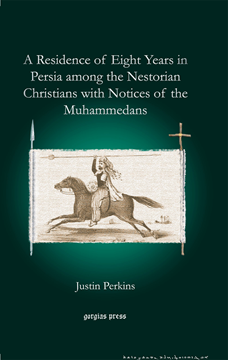The Catholicos of the East and His People
The Impression of Five Years' Work in the "Archbishop of Canterbury's Assyrian Mission"
ISBN: 1-59333-403-6
Describes the life and customs, both ancient and modern, of the modern Assyrians (“Nestorians”) who formed in the nineteenth century a remarkable outpost of Christianity in the Middle East. The authors rely in their descriptions on the Sunhadus, or Book of Canon Law, which governs that Church even today.
$178.00 (USD) $106.80 (USD)
Missionary Life in the Middle East
Or Yesterday in Persia and Kurdistan
ISBN: 1-59333-404-4
This work depicts the life of the missionary in the Middle East during the nineteenth century. The book begins with a history of Persia and its topography and character. Then the author gives a travelogue of his journeys in the Middle East, describing aspects of daily life. The modern Assyrians and Kurds get a prominent place in the book. The author describes places in modern Iran, Iraq and Turkey.
$165.00 (USD) $99.00 (USD)
Christians Under the Crescent in Asia
New Introduction by David Malick
By E. L. Cutts
ISBN: 1-59333-405-2
An account of a journey among the Assyrians in Turkey and Persia in 1876. The author, Edward L. Cutts, was sent on a mission of inquiry by the Archbishop of Canterbury in response to petitions from Assyrians to the Church of England requesting the establishment of a mission to open schools among them in order to bring about their educational and spiritual renewal.
$176.00 (USD) $105.60 (USD)
The Condition of Assyrianism in the Era of the Incarnation of Our Lord
New Introduction by David Malick
ISBN: 1-59333-406-0
Mirza Dawid Gewargis Malik (1876-1931) was a prolific writer in Neo-Aramaic (modern Assyrian). This volume contains the texts of two of his books, a collection of poems, one of which is dedicated to Nicolas II, Emperor of Russia, and Notes on the History of Assyria.
$129.00 (USD) $77.40 (USD)
History of the Syrian Nation and the Old Evangelical-Apostolic Church of the East
New Introduction by David Malick
ISBN: 1-59333-408-7
This book is the first account written in English on the history of the Church of the East by one of its own adherents. The basis of the book is a history that was written in Assyrian (Neo-Aramaic) by Shamasha George David Malech (1837-1909).
$202.00 (USD) $121.20 (USD)
A Residence of Eight Years in Persia among the Nestorian Christians with Notices of the Muhammedans
Series: Kiraz Historic Travels Archive 30
ISBN: 1-59333-410-9
Gives a travelogue and a journal of his missionary activities in the Middle East between 1834 and 1841, primarily with the Church of the East.
$228.00 (USD) $136.80 (USD)





